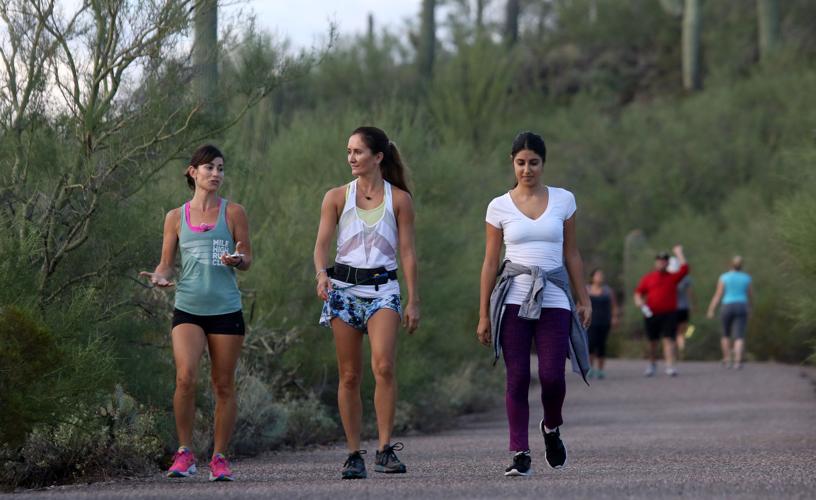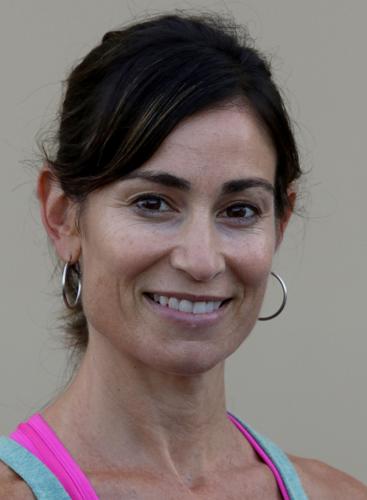Are you back?”
That is the question, perhaps the only question, and it is relatively straight-forward.
Are you back?
She looks like she’s back.
The last time we saw Tia Accetta was in May, and she was scared. She sat curled into the corner of her couch, knees tucked to her chest, just a few weeks removed from a stroke at the age of 39. Her hair covered her eyes at times, shy as she was. This was a healthy woman – forget healthy, this was a marathoner, training for an Olympic trials qualifying time – who stumbled after a long run and chalked it up to exhaustion, hunger, heat, whatever.
A stroke was the furthest thing from her mind, until, quite literally, it was the closest thing.
Less than a month later, the emotions were raw. It was still spring.
Monsoon season hadn’t started yet. It was quiet. Birds chirped. The cicadas weren’t quite buzzing yet.
Now they buzz no longer, the silent summer since passed.
She sits at a table in Rincon Market and smiles.
She feels good. Her dark hair is up. She is tan, wearing ripped jean shorts and a running shirt. Hoop earrings. She looks like she’s back. That’s the question, isn’t it?
She has others.
At the end of October, she’ll take the microphone at the American Heart Association’s Go Red For Women luncheon in Tucson, along with her husband, local running guru Randy Accetta.
They will be the event’s speakers, and Tia is trying to write her speech.
Recently, she’s written a set of questions as a prompt.
“Number one, will this happen again?” she says. “Number two, was it a sign I need to change my life? Number three is how can I protect my kids? So those are the three questions.
“Am I back? All I know is those questions weren’t there before. Now they are.”
She’s up and running again.
Feeling ‘like an athlete’
On Thursday morning, Tia is up and on her way down Tumamoc Hill. She does 20 miles a week now, maybe a few more, down from the 100 miles she ran the week of the stroke.
She’s easing her way back into things, back into life.
She still has not been on a trampoline yet. The family did a ropes course; she remained on the sidelines. But she’s paddleboarded this summer, and there have been bike rides, trail runs. Most mornings, she’ll arise before the kids and sneak in a run.
“It makes me at least feel like an athlete,” she says. “Get up early, put on my watch, run out the door and come back sweaty.”
That’s enough, for now.
She says the goal is to stay in a happy medium for as long as she can. She calls this time a “healing” period, and yes, she actually uses air-quotes when she says healing. She might as well have said it in italics.
It is harder because she cannot see any progress. She can feel progress. Her body can tell her it will allow her to push it just a little further than the last day, but it is not as if she’s had a broken arm to heal. This wasn’t even a broken brain.
It was a stroke of fate.
Her doctor, David Teeple, a Tucson-based neurologist, considers her case to be cryptogenic – the exact cause of the stroke might never be known – as are about 30 percent to 40 percent of strokes, he said. Typically, you can see some of the signs: high blood pressure, uncontrolled diabetes, high cholesterol, atrial fibrillation. Initially, with her neck still sore at the location of the stroke, doctors thought it might be a dissection, a separation of the artery wall in the neck, brain or heart. That still may have been a factor, along with extreme exhaustion and dehydration. Even her birth control pills might have played a role.
“She was on a very long run, one she’s done a million times before, but maybe this one time was the right set of circumstances,” Teeple said. “As frustrating as it was for her, all tests came back negative. We treat the things we know we can treat – take her off birth control, stay hydrated, she’s on aspirin now – and data tells us her risk of having another stroke is really, really low. May not be zero, but it’s very low.”
But wasn’t it already low?
“That is an important thing to realize: Being physically fit doesn’t make it impossible for bad things to happen,” Teeple said. “It’s always important to listen to what your body is telling you.”
Right now, her body is telling her she can go. The light is green.
Her mind is telling her to be wary. The light is yellow.
Her fear is telling her not to push it. The light is red.
Having the itch
For months, years even, Tia has seen five digits flash in her mind; 2:43:00.
That’s 2 hours 43 minutes zero seconds, the Olympic trials qualifying time for women.
She has been eying it for years.
Even now, she says, she can feel it. “That tug,” she says, “like what marathon am I gonna register for next?”
It nags at her.
“I would be happy if it didn’t come back,” she said of the feeling to compete at the highest level. “I’m not worried about it coming back. I’m worried about it always being there and never feeling like I quite reached the potential.
“I’m fine right now. My goal is to be fine for the rest of the year, enjoy this period of what I’ve been calling ‘healing’” – air quotes again – “and just sort of be in the moment and OK and happy I can do whatever I can do and ignore the little itch.”
Why is that itch even there? It’s a long story.
In college, Tia ran for the University of Idaho; she walked on to the track and cross-country teams, but eventually earned a scholarship. Her life was balanced – “I studied, I partied, and I ran,” she said. But in some ways, she left something out there.
“It wasn’t until after college that I really loved running and embraced it,” she said. “I did it because I met great people, and I got to go on trips, and I was OK at it. But looking back on it I wish I would’ve worked harder. If I was my college coach I would’ve kicked me off the team.”
And so we come to the second part of the mystery.
You see, Tia is a coach herself now. A few years back, she quit her job as a public school teacher of students with hearing difficulties and disabilities. Their kids — Aric is 8 and Anabelle is 6 – were getting older. Randy was looking to hire someone for his Run Tucson business. It was a natural fit.
Only, she had to prove something to herself first.
“If I’m a running coach and in the business, it’s extremely helpful to be able to run,” she said. “You kind of want to stay a step ahead. If I could qualify for Olympic trials, it means I could coach people to Olympic trials.”
A male committed runner can run a 2:40 marathon, she says. A woman has to be a pro to run that time. As such, a lot of women hire male coaches.
“Confidence, that’s why,” she said. “I need, just me, I need to know that I’ve done it to feel confident telling someone else to do it. I can coach people up to a certain level, but if I haven’t gotten to the next level myself? I wouldn’t hire me if I were me.”
Well, now, maybe she might.
A stroke of luck
She says this little brush with death — she calls it a stroke of luck — has made her a better coach. She is more balanced, for sure, getting more sleep, paying just a little more attention to her family life.
They recently celebrated a milestone birthday.
“I do actually feel like I’ve gotten to be a better coach,” she said. “I don’t know why. Empathy? Maybe because I have more time to focus on other people’s running? I feel bolder because I’ve had this experience happen.
“And I’m 40, so I feel kind of wise, just overnight.”
Tia isn’t hanging up the running shoes just yet.
She’s a coach, but she’s still running. She’s got to. There’s gas in this tank.
Randy holds out hope.
“She is a slow and methodical person, and as she slowly re-engages her inner athlete and it builds on itself, she will ultimately end up being the same hard-core, tough-as-nails, self-demanding marathoner,” he said. “But I think it’s going to take a number of months for her to feel confident that her brain won’t shut down.”
Is this Randy the husband talking, or Randy the coach? Are they the same?
“My job has shifted to even more of what it should’ve been earlier, and it always has been,” he said. “I really think if we’re in marital counseling or the Pearly Gates, I would say I pushed her but not in any exorbitant ways. Moving forward, I will probably not be able to help myself to say, ‘let’s go for another run.’ But my job has become to be even more her wingman and not a motivator or a challenger.”
They take this fear – and it is a “they,” and the they includes the kids – and they put it on the shelf, Randy said. He is always mindful of that fateful day in April. They thought it may have just been heat stroke, and they were wrong. As a coach, he’ll never be wrong again like that. As a husband, too.
“My caution, my mindfulness, is let’s put it on top, but in the front of the shelf, not the back of the shelf,” he said.
They still run together. They will always run together.
On Monday, they’ll take part in the 46th TMC Saguaro National Park Labor Day Run, the second leg of the Gabe Zimmerman Triple Crown that Randy organizes.
Tia will run in the 5K event, and Aric, their son, will join her.
Aric and Anabelle have handled this pretty well. Randy still chokes up when he thinks of a scene from the hospital early on. They accidentally left the iPad at the hospital, and driving home, Aric had a bit of a fit. He wanted the iPad, and he wanted it home, and he reminded Randy, again and again.
“I realized the iPad stands for mom,” Randy said. “You swap out the words and you get exactly his real emotions. How come mom can’t be home with me? I forget how this impacts them, and I think that watching her race will give them a sense of confidence in the family.”
Aric is picking up on the running these days. He frequently challenges Randy, “Dad, I’m gonna beat you.” They raced recently, and Randy had to drop back because his leg hurt.
It was a thing, Randy said, “like I’m better than my dad.”
“Now Aric feels like that about mom,” Randy said. “‘Well, she’s never gonna be good again. Mom’s done: sorry mom, I’ll be better than you.’ Having her do the race is a good step for him to see. To see her back in action.”
Ah, so there is the answer.
She’s back.









